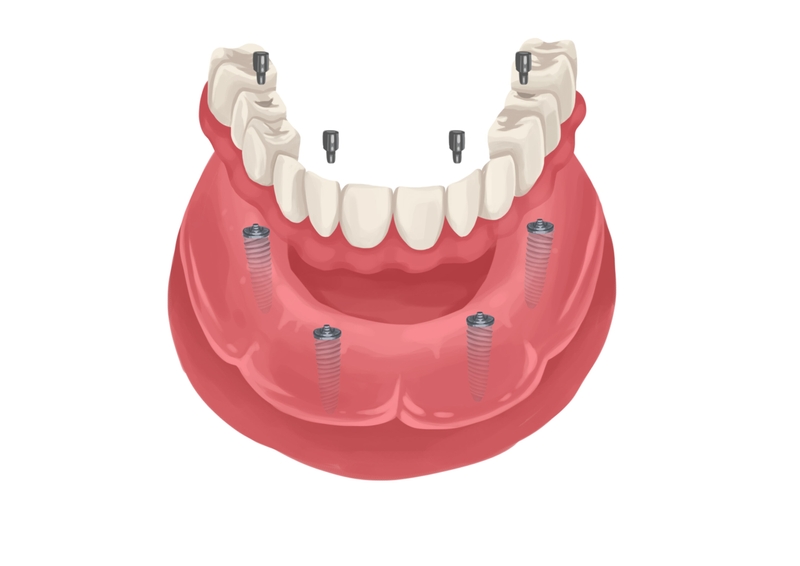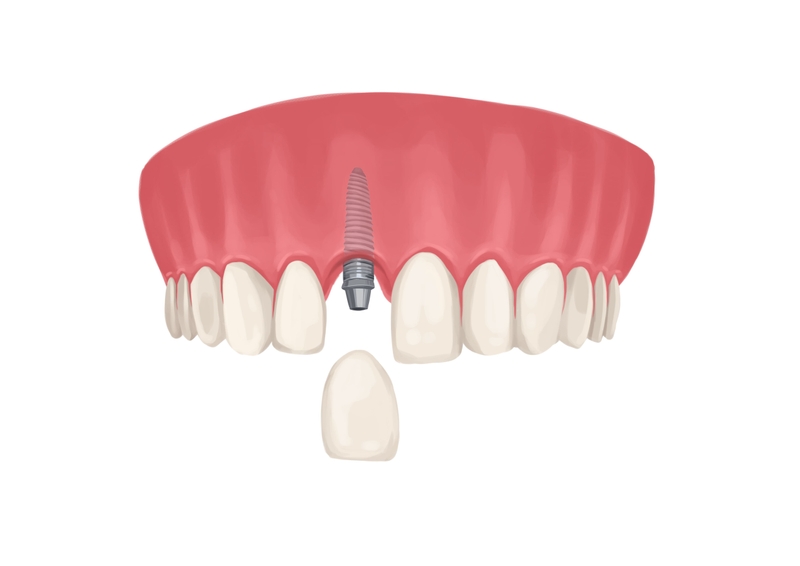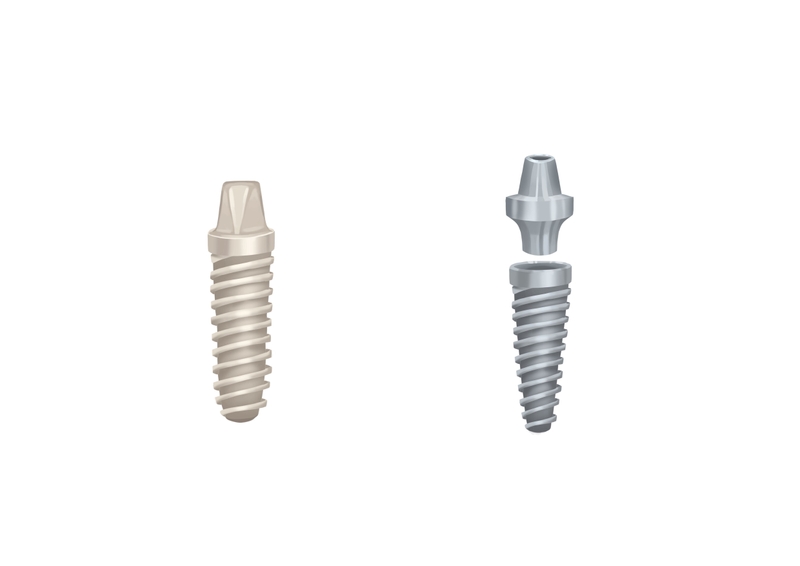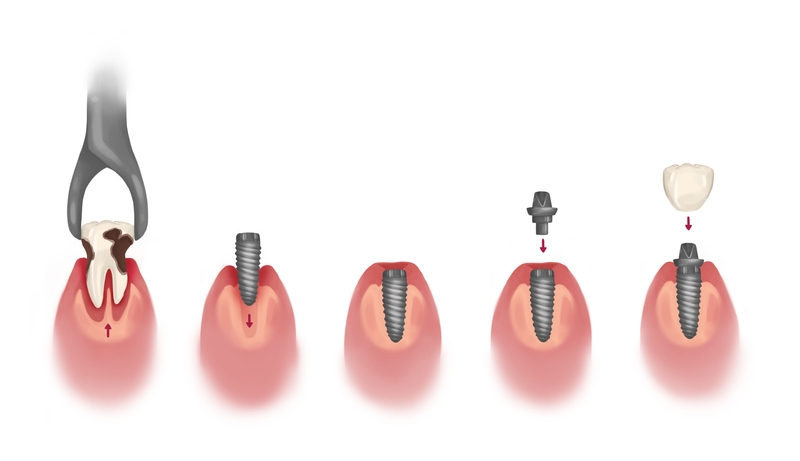- Dental implants are artificial tooth roots made of titanium or zirconia. Doctors surgically place them in the jawbone to support dental restorations, such as crowns, bridges, or dentures.
- Full-mouth dental implants replace all teeth. Single-tooth implants replace only one tooth.
- The dental implant procedure includes the fixture, abutment, and artificial tooth.
The smile you deserve is within reach. Use Authority Dental to book a dental implant dentist near you. It's simple, fast and reliable.
Do you need to choose dental implants for tooth replacement? Here's everything you need to know.
Types of dental implants
Dental implants can be divided into two main categories, depending on how many teeth they replace. You can restore a full arch or a single tooth.
Full-mouth dental implants

Picture by Authority Dental under CC 2.0 license
It is possible to replace all the teeth to give the patient a completely restored smile. Full-mouth dental implants are either permanent or removable. The first is usually mounted on four implants, like the All-On-4. The second option, called denture implants, can sometimes be done with just two. If any teeth remain, they may be extracted. The artificial dentition is customized to fit the face and mouth, giving a natural look.
Single-tooth implant

Picture by Authority Dental under CC 2.0 license
If you are missing a single tooth, your implant will support a single crown. It will still replace the root, which will stimulate the bone. Single tooth implants are often recommended for front tooth replacement.
A single tooth implant is an excellent alternative to a bridge, as it does not damage adjacent natural teeth. It stands on its own, providing the patient with full functionality and impressive aesthetics. 2 implants can support a bridge if a patient is missing multiple neighboring teeth.
Dental implant parts
A tooth restoration in the form of an implant is composed of three main parts. Those are the fixture, the abutment, and the artificial tooth.
Fixture
Also called an implant body or post, it goes into the hole in the gum where the tooth is missing. The implant post resembles a screw, and it is the part that fuses to the bone. Placing this is a short surgical procedure.
After the fixture is in place, a healing cap is placed to ensure the gums grow around it properly. The surgeon may wait 6-8 weeks before placing a healing abutment.
Abutment
Once the post and bone have fused, the gum will be reopened to attach the dental implant abutment. It looks like a short, metal tooth, and it is screwed or cemented in place. The dental implant screw acts as a connector between the post and the crown or bridge (fake tooth).
Crown or bridge
A crown is used for single-tooth implants. It is the only part that is visible in the mouth once the restoration is complete. Gums grow around it, giving the tooth a natural appearance. Dental implants and crowns can be matched to the color and size of surrounding dentition for a fully customized look.
When multiple teeth are replaced, you will be fitted with a bridge or a denture.
What are dental implants made of?

Picture by Authority Dental under CC 2.0 license
The most common dental implant material is titanium. They can also be made from zirconia. Both of these are durable and cosmetically pleasing. Your dentist will help decide which is right for you before scheduling your dental implant procedure.
Titanium
Titanium dental implants have been used for decades. It is a biocompatible material, making it ideal for osseointegration. Titanium is durable, lightweight, and resists corrosion.
Titanium implants have a success rate of roughly 97%. Patients with allergies should have the MELISA test to ensure the implant will not cause an allergic reaction, though this is rare.
Zirconia
Ceramic dental implants require greater expertise from the dental practitioner to be placed correctly, as they are less durable. This kind of implant comes in two pieces. The abutment and crown, which are connected, are made of zirconia, while the actual implant body is still titanium.
Zirconia implants are often marketed as more aesthetic. Such implants are tooth-colored, which makes them appear even more natural. Titanium rods can sometimes be slightly visible at the gumline.
Dental implant procedure

Picture by Authority Dental under CC 2.0 license
Getting a single implant can take as little as a couple of hours or as long as 2 years. There are a few things that indicate how long the whole thing takes:
Your general dental and gum health,
The number of teeth you want to replace,
Which teeth you want to replace,
Whether you need extractions, and
Whether your jawbone requires grafting.
If you do not need additional procedures and your oral health is in good condition, the implant process can take about 9 months. Some solutions give you one-day implants, but not everyone is a candidate for this.
Consultation and treatment plan
The first step of the tooth implant procedure is a consultation. It may take a few weeks to schedule. This visit may include X-rays and/or dental impressions to examine the inner structures of your mouth. It is not uncommon to see a few different specialists. A treatment plan is devised.
The implant dentist will review your medical history. Make sure to disclose any underlying conditions and what medication you are regularly taking. If you are suffering from periodontitis, this should be treated before the process begins.
Associated procedures
Tooth extractions and bone grafting are the most common procedures associated with tooth implantation. The latter may involve up to 12 months of healing. Neither might be necessary in your case, but it is worth knowing what they are if it does come up during your consultation.
If you still have a tooth (or teeth) where you want the implant (or implants), an extraction will take place. Most often, though, dental implants replace missing teeth or badly damaged dentition.
Dental implant surgery
The next step is surgery. Implant procedure pain can be managed with some type of anesthesia. The most popular means are local injection, IV, or general sedation.
Your gum will be cut open to expose the bone. A drill will be used to make a small hole that will allow the titanium rod (implant) to be inserted. That can take up to a couple hours. You will leave the office with sutures and might have a separate appointment to remove them.
Osseointegration
Osseointegration is the fusion of an implant and bone. This stage is key for a successful dental implants process. The material of the rod is biocompatible, which means bone can grow into it. Bone density and successful osseointegration are the most important factors influencing implant longevity. This is what makes dental implants such a durable solution.
The process takes 3 to 6 months on average, with up to 7 for the upper jawbone. You will get a healing collar once this is complete. It is a round piece of metal that prevents gum tissue from growing over the implant. It will stay on for 10-14 days.
Abutment placement
The healing collar will be removed once the gums have fully recovered. The next step is placing the abutment, a piece of metal that will secure the crown (tooth cap), bridge, or denture. This can be “skipped” if this step takes place at the same time as the implant.
Although recovery from this procedure takes only 2 weeks, you will have to wait about 6 weeks for the next one. This is how long it takes to make a permanent crown. Until then, you might wear a temporary one. Otherwise, the abutment will be visible in the tooth gap.
Installing artificial teeth
The final stage is placing the dental crown, bridge, or denture. This looks like natural dentition. If you are not getting a full arch, the color and shape will be matched to the neighboring teeth.
Impressions of your healed mouth will be taken and the artificial teeth will be made. The crown, bridge, or denture is placed, screwed, or cemented into the abutment. With snap-in dentures, you can remove them yourself for cleaning.

Pros and cons of dental implants
Life-long solution
Most durable tooth replacement option
No issues with smiling, eating, or talking
Stimulate the bone and prevent reabsorption
High success rate
Look just like natural teeth
Expensive
The process can be long
Additional procedures might be necessary
Some patients are allergic to titanium
Lee emphasizes: "The true value of an implant lies in its structural integrity. When you lose a tooth, the jawbone begins to shrink from lack of stimulation, a process known as resorption. Because an implant mimics a natural root, it transmits chewing forces back into the jaw, keeping the bone dense and healthy."
"With over 3 million Americans currently utilizing this technology, it has become the gold standard for preventing the 'sunken' facial appearance associated with long-term tooth loss," he stresses.
Dental implants data and facts
Implants fuse to the bone and stimulate growth, making your jaw stronger.
Implants can’t get cavities.
3 million people in the US have dental implants, and 500,000 more are installed every year.
Almost 90% of people can’t afford dental implants.
The first successful dental implantation in a human was performed in 1965.
Dental implants can be done in just one day.
Studies show that smokers have a success rate of 84.2%, while for non-smokers it is 98.6%.
The history of dental implants shows that this technique dates back to ancient times. They were made from bamboo pegs, precious metals, ivory, or even other human teeth.
FAQ
When can you get an implant after losing a tooth?
If you have enough bone volume, an implant can be placed the same day your tooth falls out or is extracted. Dentists often recommend 3 to 6 months of healing nonetheless.
If you lost a tooth a long time ago, you are likely to need bone grafting to thicken the bone. It will ensure the base is stable enough to support an implant.
How long does a dental implant procedure take?
The surgery itself takes about two hours. The whole process, including the initial consultation, extractions, bone grafting or sinus lifting, healing, restoration placement, and recovery, can take about 2 years.
One-day dental implants are possible, but only the surgical procedures are performed in a single day. Sometimes you can walk out with a new set of teeth, but they are often temporary and have to be replaced with permanent ones about 6 weeks later.
Are dental implants safe?
Dental implants have an incredibly high success rate, about 93%. The method has only been improved since 50 years ago when it was first conducted. There is little to no risk if an experienced specialist performs the surgery. Complications are rare and mostly due to patient noncompliance.
References
- The Impact of Edentulism on Oral and General Health
- Tobacco as a risk factor for survival of dental implants
- Titanium allergy tests
- Diagnostic Imaging for Dental Implant Therapy
- Treatment planning for implant restorations
- The importance of a thorough medical and pharmacological history before dental implant placement
- Osseointegration
- Bone growth around dental implants
- Tooth Implant vs Bridge: What Top Dentists Are Recommending
- Air-Abrasive Disinfection of Implant Surfaces in a Simulated Model of Periimplantitis
Harry Lee, DMD
In my practice, I often describe a dental implant not as a new tooth, but as a new root. Unlike a denture that sits on top of the gums like a rug, an implant is a titanium post surgically placed into the jawbone. It is the only restoration with a success rate exceeding 97% because it doesn't rely on neighboring teeth for support. It stands entirely on its own, providing a foundation that is virtually indistinguishable from your natural anatomy.